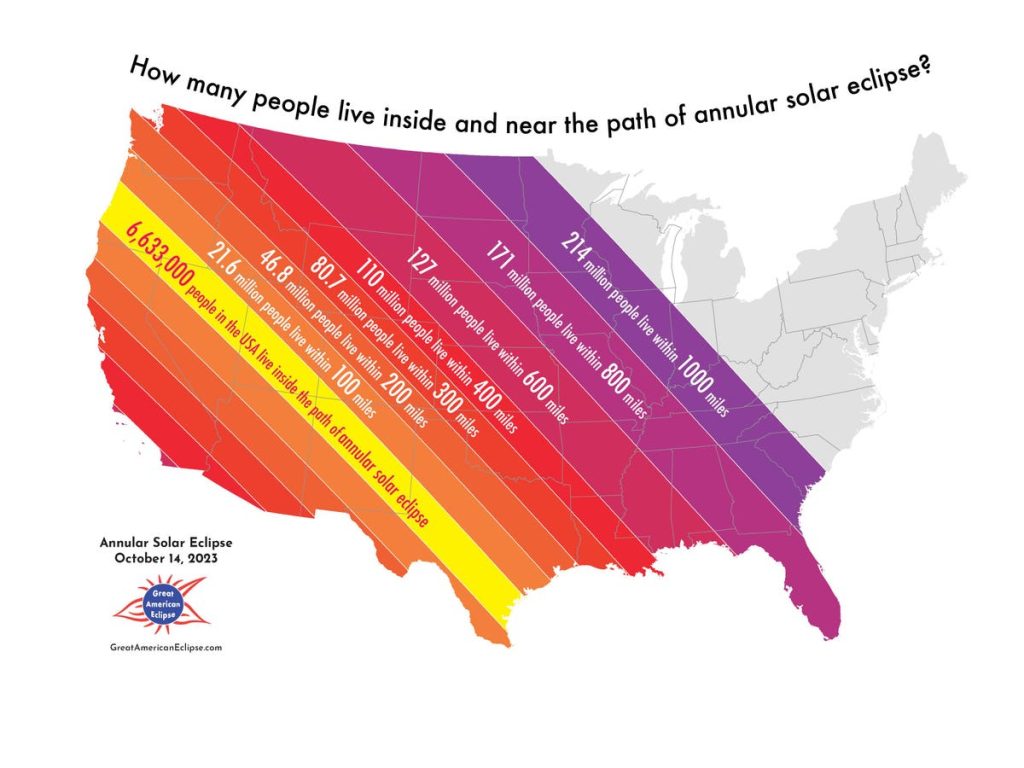When is the next eclipse? On Saturday, October 14 at 16:15 Universal Time—9:15 a.m. PDT—those close to the Oregon Dunes will see a perfect “ring of fire” as the moon covers the center of the sun for 4 minutes 30 seconds.
Over 70 million Americans could see the rare celestial sight, according to NASA.
The first such sight visible in the U.S. since 2012—and the last until 2039—this annular solar eclipse (annulus means ring) will be visible only from within a 125 miles wide path.
Everyone else in North, Central and South America will see a partial solar eclipse. Solar eclipse glasses will need to be worn at all times whether you’re on target to see a “ring of fire” or a partial solar eclipse.
Where Is The ‘Ring Of Fire’ Solar Eclipse?
That path will touch nine U.S. states as it travels southeast across the U.S. Southwest region, exiting the nation at 12:03 p.m. CDT over Padre Island, Texas, where the ring will be visible for up to 4 minutes 52 seconds.
In total over 6.6 million Americans live in the path of the “ring of fire” during the 47 minutes it takes to cross the nation—but many more could see it. “The path of the annular solar eclipse crosses a big swath of the U.S. from Oregon all the way down to Texas, and touches parts of California, Nevada, Utah, Arizona, Colorado and New Mexico,” said Alex Lockwood, strategic content and integration lead for NASA’s Science Mission Directorate, NASA Headquarters, in a press briefing. “They can walk outside and safely, hopefully, view the fun,” said Lockwood. “There’s another 68 million people who live within 200 miles of the path—so over 70 million people could witness this incredible celestial alignment.”
After the U.S. the “ring of fire” will be seen from Mexico’s Yucatan Peninsula, Belize, Honduras, Nicaragua, Panama, Colombia and Brazil.
Best Places To See The ‘Ring Of Fire’ Solar Eclipse
You’re not the only one who knows about this rare solar eclipse. If you’re making a plan at this late stage then the best place to watch the eclipse will be anywhere within the path of the “ring of fire” that won’t be frequented by others.
This “ring of fire” is unusual in that it crosses some of the best known and most beautiful U.S. national parks. However, those in the know have long booked out campsites and accommodation in or close to these areas.
At this late stage it’s best to avoid anywhere that’s likely to attract huge numbers of visitors. Honeypot sites are bound to include Crater Lake National Park in Oregon and Bryce Canyon National Park in Utah. A recent announcement confirmed that Monument Valley Navajo Tribal Park will be closed, as will Four Corners Navajo Tribal Park and parts of Canyon de Chelly National Monument.
Wherever you plan to go, plan for crowds—and get to your viewing location well in advance of the partial eclipse starting. You can find out the exact time for any location using the “eclipse lookup” option here.
How To Travel Responsibly In Backcountry Areas
Many backcountry areas of Utah, New Mexico, Nevada, Arizona, and Colorado could see significant visitation, which could create pressures on local services and businesses. Be aware that visitors to backcountry locations will have limited facilities and resources. Be prepared to bring everything you need—a full tank of fuel, food, cash, toilet paper, ice—because it may not be available at your intended destination. Also note that in Navajo culture the event is sacred and many Navajo tribal members will not be be working.
Best Cities To See The ‘Ring Of Fire’ Solar Eclipse
Perhaps the best places to consider going to see the “ring of fire” solar eclipse are the three biggest cities each in the three most populous U.S states it crosses—Eugene in Oregon, Albuquerque in New Mexico and San Antonio in Texas. Prices are rising, but a fly-in, fly-out eclipse experience is still possible.
Where Is The Partial Solar Eclipse?
Although you must be within the path of annularity to see the “ring of fire” on October 14, everyone in the Americas will see a partial solar eclipse (those in the path will also see one both before after the “ring of fire”).
How much of the sun will be covered from the moon depends on how close you are to the path of the “ring of fire.” For example, if you are in Denver, Colorado, 400 miles north of the path at Santa Fe, New Mexico, you’ll see 79% partial solar eclipse. In Los Angeles, its 71% since that city is 450 miles south of the path at Cedar City, Utah. However, those in New York, which is about 1,800 miles from the path, the sun will appear to be eclipsed by only 22% by the moon. However, in Austin, Texas just 70 miles from the path a huge 88% eclipse will be seen—but no “ring of fire.”
I’m an expert on eclipses—the editor of WhenIsTheNextEclipse.com and author of The Complete Guide To The Great North American Eclipse of April 8, 2024. For the very latest on the “ring of fire” solar eclipse—including travel and lodging options—check my main feed for new articles each day.
Wishing you clear skies and wide eyes.
Read the full article here










